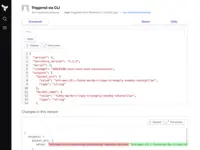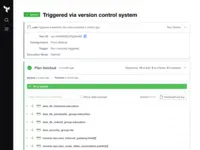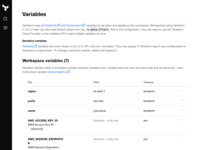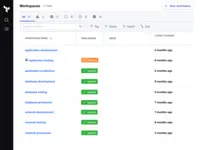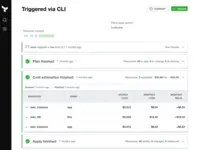Overview
What is HashiCorp Terraform?
Terraform from HashiCorp is a cloud infrastructure automation tool that enables users to create, change, and improve production infrastructure, and it allows infrastructure to be expressed as code. It codifies APIs into declarative configuration files that can be shared amongst…
HashiCorp Terraform - make IT boring again (in a good way...)
Terraform - Codify your infrastructure
The main reason for using Terraform is to allow us to reliably …
The de facto tool for provisioning infrastructure today
Cloud Engineer review of Terraform
Terraform - Best Cloud-agnostic Infrastructure Provisioning Tool.
Terraform Review
Really good tool for Infrastructure
Terraform for Automation
Terraform Review
Terraform Review
Terraform is the Perfect Tool for Building Infrastructure as Code
Infrastructure as code, finally!
Infrastructure Configured
A great automation tool for everyone
Makes your environment more reliable and easily replicable.
Reviewer Pros & Cons
Pricing
Open Source
$0
Team & Governance
$20/user
Enterprise
Contact sales team
Entry-level set up fee?
- No setup fee
Offerings
- Free Trial
- Free/Freemium Version
- Premium Consulting/Integration Services
Product Demos
Infrastructure Pipelines with Terraform Cloud
Product Details
- About
- Competitors
- Tech Details
- FAQs
What is HashiCorp Terraform?
Terraform creates and manages resources on cloud platforms and other services through their application programming interfaces (APIs). Providers enable Terraform to work with virtually any platform or service with an accessible API.
HashiCorp Terraform Features
- Supported: Manage any Infrastructure
- Supported: Track your infrastructure
- Supported: Automate changes
- Supported: Standardize configurations
HashiCorp Terraform Screenshots
HashiCorp Terraform Competitors
HashiCorp Terraform Technical Details
| Deployment Types | Software as a Service (SaaS), Cloud, or Web-Based |
|---|---|
| Operating Systems | Unspecified |
| Mobile Application | No |
Frequently Asked Questions
Comparisons
Compare with
Reviews and Ratings
(122)Community Insights
- Pros
- Cons
- Recommendations
Fast and Reliable Infrastructure Deployment: Users appreciate Terraform's ability to deploy infrastructure quickly and reliably. Several reviewers have mentioned that they were able to provision resources efficiently, saving them time and effort in the deployment process.
Modular Approach with Reusable Modules: The use of modules in Terraform is highly valued by users, as it enables repeatability and encourages code reuse. Many reviewers have stated that they find it easy to share and reuse functionality across deployments, promoting collaboration and consistency among teams.
Large Ecosystem of Modules for Various Providers: Users highly value the extensive ecosystem of modules available in Terraform for various providers. Numerous reviewers have stated that this allows them to easily access strong default configurations for many services, saving them time and effort in setting up their infrastructure.
Complex Documentation: Many users have found the documentation for the new language to be complex and lacking clear explanations, making it difficult for them to understand and use Terraform effectively. They express frustration with the lack of concise and intuitive explanations in the documentation, which hinders their ability to grasp key concepts.
Challenging Rollback Operations: Users have expressed difficulty in performing rollback operations as it must be done through version control. This process is seen as cumbersome and unintuitive, requiring extra steps that could be simplified with a dedicated rollback feature within Terraform itself.
Unusual Language Design: The language used in Terraform is considered unusual by many users, which makes it challenging for new users to understand and navigate the codebase. Some users find it unconventional compared to other infrastructure-as-code tools, leading to confusion when reading or modifying existing code.
Users have provided several recommendations for Terraform based on their experiences with the tool for automating cloud infrastructure management.
First, users suggest taking the time to understand and implement Terraform modules properly. This recommendation emphasizes the importance of familiarizing oneself with the module system in order to effectively leverage the capabilities of Terraform.
Second, users recommend reading through the documentation and reaching out to Hashicorp for assistance when facing issues. By doing so, users believe that they can overcome any challenges they encounter and make the most of Terraform's features.
Lastly, some users advise considering other Infrastructure as Code (IaC) platforms, but acknowledge that Terraform is a great and flexible open-source option. This recommendation highlights the need for users to evaluate different options before making a final decision on their cloud infrastructure automation tool.
Attribute Ratings
Reviews
(1-25 of 25)Terraform - Codify your infrastructure
Terraform is well suited to any size of team thanks to the use of workspaces and proper use of version control will allow work on branches without upsetting anything in production.
The de facto tool for provisioning infrastructure today
Terraform framework can be considered complicated to write efficient code, especially if you are doing some more complex use cases.
Creating efficient CICD pipelines is quiet challenge , I believe Terraform future will be replaced by Kubernetes operators.
Cloud Engineer review of Terraform
Terraform Review
Really good tool for Infrastructure
Terraform for Automation
Terraform Review
If you are leveraging AWS and have a team already comfortable with their offerings like Cloud Formation, I would choose to stay or start in the AWS eco-system.
Terraform Review
- For long running resources, having a single source of truth for their desired configuration is handy, since that configuration can drift over time.
- For short running or experimental cases, Terraform code can be used to quickly spin up environments before spinning them down just as quickly.
- If a reference architecture is needed, Terraform code can be used to describe all the resources that make up a stack.
Infrastructure as code, finally!
Infrastructure Configured
A great automation tool for everyone
Makes your environment more reliable and easily replicable.
Using Terraform to Automate Your Future
Terraform for the win
Terraform: a great infrastructure as a code tool
Why I used Terraform
- Terraform is a well contributed open source project but support is average
- Coverage of various tools is great where only important functionalities were covered like in Chef
- It provides the automation from various pieces but running the same from scripts/other external inputs would be great
- Interpolations are supported but not well enough
- Secret management is poor and needs support on special characters
Infrastructure as Code Done Right!
Terraform Improved our World
Terraform - Automate your company's IT
VM provisioning
VM clustering
Automation


